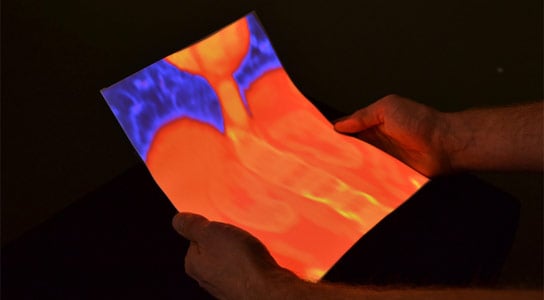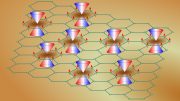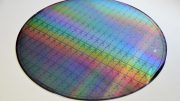
Body-based navigational aid: With Flexpad, IT experts in Saarbrücken are able to better analyze images, such as computer tomography, as moving the paper or other flexible material calls up different images onto the material, which also functions as the monitor. Credit: Jürgen Steimle
Using a Kinect camera and a projector, Flexpad transforms flexible materials into highly deformable and spatially aware handheld displays.
Recently at the 2013 IFA International Trade Show for consumer electronics and home appliances in Berlin, major electronics manufacturers displayed new types of displays that are thin, and even curved, but expensive. IT experts in Saarbrücken have gone a step further. Their more cost-effective approach, called Flexpad, allows a simple, standard sheet of paper to be transformed into a moveable, flexible display. Already today, this could help patients better review the results of a computer tomography, for example. In the long term, the IT experts want to discover what new applications are viable in the future for ultra-thin, deformable, mobile end devices, and how they can best be operated.
Human organs shimmer in red on a sheet of paper displaying a longitudinal view of the human abdomen. The spinal column and pelvic bones form contrasting yellow islands. As the sheet of paper is bent downwards at the ends, the bones appear to come into the foreground while the soft tissue recedes (see video). What appears to be science fiction at first glance, is the result of the “Flexpad” research project developed under the leadership of Jürgen Steimle in the Media Lab at the Massachusetts Institute of Technology in the US and the Max Planck Institute for Informatics in Saarbrücken, in cooperation with Kiel University. In the meantime, Steimle heads the Embodied Interaction research group at the Multimodal Computing and Interaction Cluster of Excellence.
“We routinely deform objects intuitively in many different ways. We bend back pages in books, deflate balls, fold paper, and sculpt clay”, explains Jürgen Steimle. “And by projecting user interface elements onto tangible, deformable objects we can control computers and other technical devices better and more easily.”
A depth camera records the motions of hands and paper
In order for his ideas to function in the digital world, only a small amount of technology is required meanwhile – however, all the more programming and brain work. “For one thing, we use a projector that reproduces an image or a video on a sheet of paper”, says Steimle, describing the approach. “For another, we work with a Kinect sensor from Microsoft. The depth camera permits people to use their movements to control computer games. In our case, it records the hands and paper to determine their position in space.” To capture the movements of their hands and the paper, the projector and camera are mounted in the ceiling above the user.
Flexpad thereby works as follows: The motion sensor records the user and the paper, capturing the paper’s deformation and movement. So that the recording takes place precisely and in real time despite the rather coarse image data from the Kinect camera, the researchers have developed and implemented two algorithms. The first initially subtracts out the interference caused by the fingers and hands of the user. If the user moves the paper – whether left or right, or bends it into an arc or wavy form – the camera senses this. A specially developed computer model subsequently describes these movements in fractions of a second, so that the projector can reproduce it on the sheet in near real time.
With Flexpad, diagnosis consultations become simpler
Nevertheless, Flexpad has certain limits: The user must stand in a particular area under the camera and projector for the system to work properly. Therefore, the user cannot move freely around the room.
“The paper takes on two simultaneous functions in our system”, explains Steimle. “It is input device and display at the same time.” The user can interact with the device in a similar way to using a mouse for controlling a computer. Other materials besides paper are also suitable, for example, sheets of plastic or other deformable materials. The only important thing is that they possess a certain malleability and flexibility.
Active flexible displays, as they are referred to, go one step further. According to the study “OE-A Roadmap for Organic and Printed Electronics” from the Organic and Printed Electronics Association, these will be available for end users in just ten years. “Our concepts, which we are researching using Flexpad, can be transferred to this new type of display”, explains Steimle. However, applications based on the cost-effective technology are already conceivable. “In medical diagnostics, the physician can quickly and easily discuss for instance the results of computer tomography with the patient. In addition, the system can operate as a kind of interactive children’s book in which certain figures, like a goldfish, can move”, says Steimle.
Reference: “Flexpad: Highly Flexible Bending Interactions for Projected Handheld Displays” by Jürgen Steimle, Andreas Jordt & Pattie Maes, 27 April 2013, 2013 ACM SIGCHI Conference on Human Factors in Computing Systems.
DOI: 10.1145/2470654.2470688









Be the first to comment on "Flexpad Turns Flexible Materials into Displays"